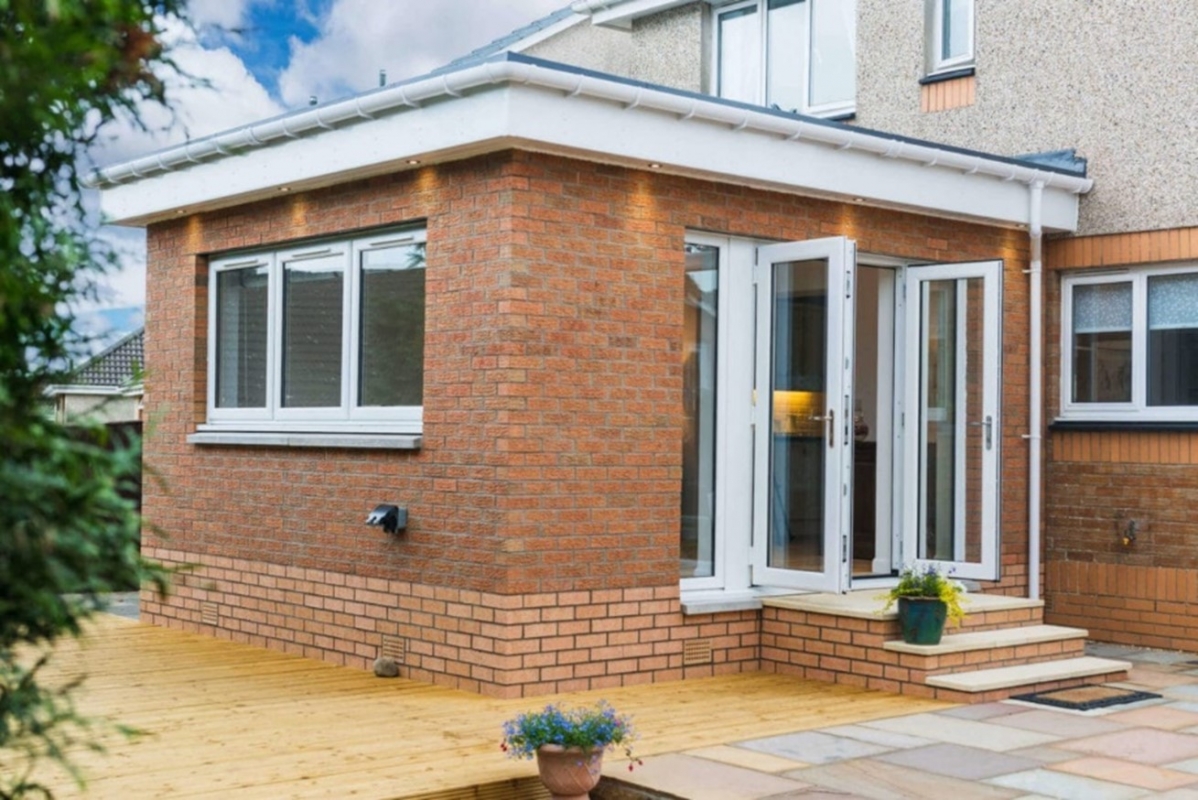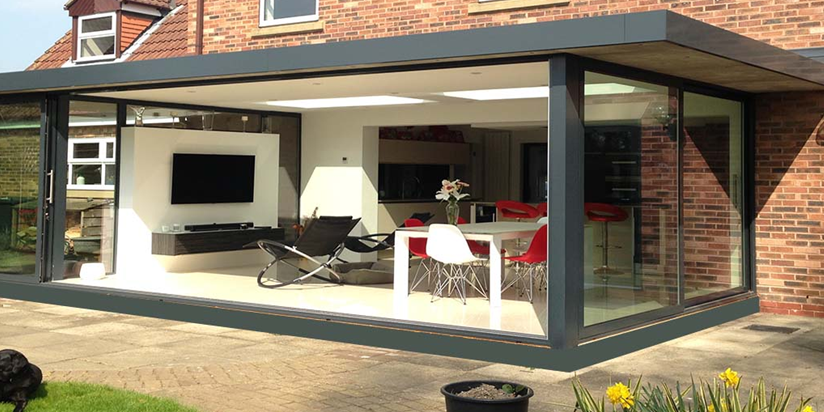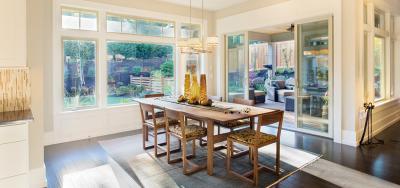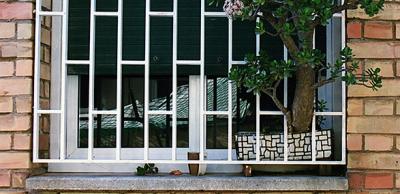Can I have a fully glazed extension on my house?
The building regulations provide controls for building work to be done for health, safety, security, welfare, convenience, access for people in and about buildings and for energy efficiency purposes. The requirement for energy efficiency is laid out in, what is commonly referred to as, Part L of the building regulations.
Requirement L1 says:
Reasonable provision shall be made for the conservation of fuel and power in buildings by:
- limiting heat gains and losses
- through thermal elements and other parts of the building fabric
- from pipes, ducts and vessels used for space heating, space cooling and hot water services
- providing fixed building services which
- are energy efficient
- have effective controls
- are commissioned by testing and adjusting as necessary to ensure they use no more fuel and power than is reasonable in the circumstances
The fashion for home extensions has, over the years, changed substantially.

Traditional brick and flat roof house extension with window and patio door (image by SRJ windows).
Modern extension designs now tend to incorporate large amounts of openings for: glazed walls, doors, windows, and roofs.

Contemporary substantially glazed house extension (image by Townscape Architects).
Unfortunately, lightweight, and glazed systems – even highly specialised windows – do not tend to perform as efficiently as highly insulated opaque walls and roofs (some glazing systems can be designed to be highly energy efficient, but these might be too expensive for most domestic extensions).
Reducing energy consumption and CO2 emissions
Approved Document L1B - Conservation of Fuel and Power in Existing Dwellings contains guidance to support the requirement on energy efficiency and can place a limit on the number of windows, doors and roof windows that can be incorporated into an extension.
The rule is relatively simple: the total amount of all external doors, windows, and roof windows, as a proportion of the internal floor area of the extension, should not be more than 25%.
As a result, that total area of all the windows, doors, walls, rooflights, bi-fold or patio doors etc. contained in an extension, should – when added together – amount to no more than ¼ of the floor area of the extension; for example, an extension with a planned internal floor area of 40m2 (which might span over the ground and 1st floor levels) should have no more than 10m2 of windows, roof windows, and doors; however, there is also an additional factor that can permit more window or door area. If the new extension also covers over some existing windows or doors etc. then it is permitted to add the area of these to the 25% limit mentioned above.
So, using the previous example, the extension will cover a large part of the existing rear elevation of a house, covering both the existing rear lounge and kitchen windows, a kitchen door and a 1st floor bedroom and bathroom window. The total area of all the windows and door amounts to 10m2. As a result, this 10m2 can be added to the 10m2 allowed for the 25% rule, which gives a total area of 20m2. This means that the area of all the doors and windows will be 50% of the floor area of the extension.
It’s not unusual though, with modern extensions, to see almost fully glazed walls and large areas of glazing on roofs, all of which is likely to amount to much more that the 25% limit (or even an extended proportion, to account for existing windows and doors that might be covered over).
Dealing with windows and doors that are much larger than Part L permits
Where practical, either the U-Value of the window should be improved relative to the standard set out in table 1 of Approved Document L1B, or other compensatory measures should be applied.
It can be complicated to improve the the U-Value and it requires careful consideration of the energy performance of a window, door or roof window; however, alternative options can be used.
Calculate the overall area weighted U-Value for the extension on its own
This calculation can help to show that the area-weighted U-Value of all the elements (walls, floors, roof windows etc) in the extension is not more than that of a similar extension having the same size and shape, but which complies with the minimum U-Value standards for all the walls, floors, roof, and the opening areas as set out in the Approved Document.
The area-weighted U-value is given by the following expression:
{(U1 x A1) + (U2 x A2) + (U3 x A3) + …)}
{(A1 + A2 + A3 + …)}
Where: U = the U-Value of the element e.g.: wall U1, roof U2, floor U3 etc.
A = the total area of the element (m2) e.g.: wall A1, roof A2, floor A3 etc.
Calculate the whole dwelling
This option offers more freedom of design.

This normally requires the services of a trained energy assessor to carry out the calculation – using approved software, known as SAP (standard assessment procedure) 2012. This approach shows that the calculated carbon dioxide (CO2) emission rate from the dwelling, together with the proposed extension, is not greater than that for the dwelling with a similar (notional) extension built to the standards laid out in Approved Document L1B and which has openings that also meet with the guidance in L1B, but with the door area set as equal to the door area of the proposed extension and the remainder of the openings being classified as windows.
SAP 2012 can also be used to estimate the performance of the elements of the existing building – known as an RdSAP (reduced data standard assessment procedure) assessment.
You may need to speak to Building Control
If the existing house needs insulation improvements, to allow the extension to have larger areas of windows and doors etc. these might also require building regulations permission and you should check with your local authority Building Control team beforehand.
Please Note: Every care was taken to ensure the information was correct at the time of publication. Any written guidance provided does not replace the user’s professional judgement. It is the responsibility of the dutyholder or person carrying out the work to ensure compliance with relevant building regulations or applicable technical standards.
Sign up to the building bulletin newsletter
Over 48,000 construction professionals have already signed up for the LABC Building Bulletin.
Join them and receive useful tips, practical technical information and industry news by email once every 6 weeks.
Subscribe to the Building Bulletin




Comments
LABC response
Submitted 2 years 9 months ago
Thank you for your comment.
LABC is a membership organisation, providing advice and support to its member local authorities around England and Wales. As a result, LABC cannot comment on the application and enforcement of the Building Regulations on individual cases, as this is a matter for the local council – being the enforcing authority for building regulations.
The 2006 version of Approved Document L1B (in England and Wales) defined the amount of translucent material needed to differentiate between a “substantially glazed extension” and a “conservatory”. A conservatory generally needed at least 50% of its external wall area and 75% of its roof area to be formed from translucent materials, along with other certain requirements relating to thermal separation and the like. However, this definition was removed in the 2010 version of Approved Document L1B (in England and Wales).
However, the guidance in the current Approved Document L Volume 1 (2022 edition for Wales) should be followed, in particular Section 13 that provides information on optional approaches for more design flexibility when the proposed amount of glazing in an extension exceeds the 25% rule mentioned in the above article.
Kind regards,
LABC Team
Add new comment